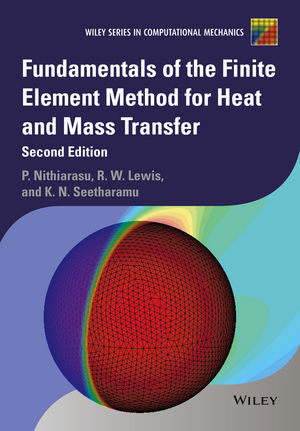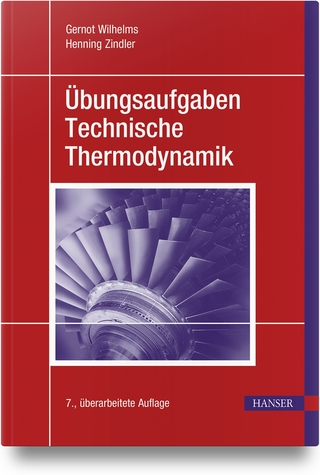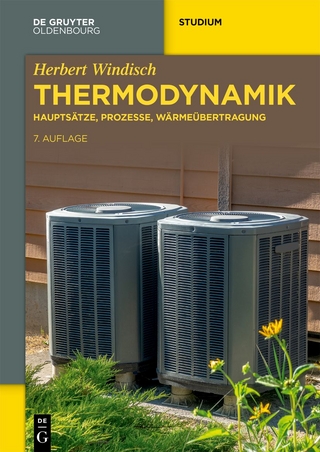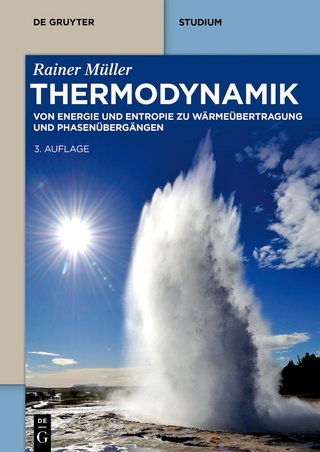
Fundamentals of the Finite Element Method for Heat and Mass Transfer
John Wiley & Sons Inc (Verlag)
978-0-470-75625-6 (ISBN)
Fundamentals of the Finite Element Method for Heat and Mass Transfer, Second Edition is a comprehensively updated new edition and is a unique book on the application of the finite element method to heat and mass transfer.
• Addresses fundamentals, applications and computer implementation
• Educational computer codes are freely available to download, modify and use
• Includes a large number of worked examples and exercises
• Fills the gap between learning and research
Perumal Nithiarasu, DSc, PhD, is currently the head of Zienkiewicz Centre for Computational Engineering at Swansea University. He has more than twenty years of teaching and research experience in the areas of finite element method, heat and mass transfer, fluid dynamics and biomedical engineering. He is a founding co-chair of the international conference series, Computational Methods for Thermal Problems (ThermaCOMP, www.thermacomp.com). Professor Nithiarasu is a winner of ECCOMAS young investigator award in 2004 and he was awarded the Zienkiewicz Silver Medal of the Institution of Civil Engineers, UK in 2002. Professor Nithiarasu has published more than 300 articles and two textbooks in the areas of heat and fluid flow.?Professor Nithiarasu is the founding editor of the International Journal for Numerical Methods in Biomedical Engineering, published by Wiley. He serves on the editorial boards of several international journals. Roland Lewis, DSc, PhD, FREng, has more than forty years of experience in teaching, research and administration in the area of heat transfer. Previously, Professor Lewis served as the head of Mechanical Engineering department in Swansea University.?His contributions in the areas of solidification and porous media are very well known. Until recently, he was the editor in chief of the International Journal for Numerical Methods in Engineering and Communications in Numerical Methods in Engineering. Although retired, he is actively editing the International Journal of Numerical Methods for Heat & Fluid Flow. He has also been serving as the honorary chair of the international conference series, Computational Methods in Thermal Problems (ThermaCOMP, www.thermacomp.com).?Author of nearly 400 articles, Professor Lewis was honoured with IACM Computational Mechanics award and fellowship. He is also a fellow of the Royal Academy of Engineering, UK. K.N. Seetharamu currently holds a prestigious chair professor position in the Mechanical Engineering department of the PES University, Bangalore. He has more than forty years of teaching and research experience in the areas of heat transfer and finite element method. Previously he was a professor of Thermal Engineering in Institute of Technology Madras.?Professor Seetharamu also has spent more than ten years in University of Sains Malaysia, carrying out research in the areas of heat transfer, energy and electronics packaging.?Author of more than 300 publications, Professor Seetharamu is one of the top heat transfer engineers in India. He is a fellow of the Indian National Academy. Recently, the Indian Society for Heat and Mass Transfer has established a biennial award in his name to honour Professor Seetharmau's achievements.
Preface to the Second Edition xii
Series Editor’s Preface xiv
1 Introduction 1
1.1 Importance of Heat and Mass Transfer 1
1.2 Heat Transfer Modes 2
1.3 The Laws of Heat Transfer 3
1.4 Mathematical Formulation of Some Heat Transfer Problems 5
1.4.1 Heat Transfer from a Plate Exposed to Solar Heat Flux 5
1.4.2 Incandescent Lamp 7
1.4.3 Systems with a Relative Motion and Internal Heat Generation 8
1.5 Heat Conduction Equation 10
1.6 Mass Transfer 13
1.7 Boundary and Initial Conditions 13
1.8 Solution Methodology 15
1.9 Summary 15
1.10 Exercises 16
References 17
2 Some Basic Discrete Systems 19
2.1 Introduction 19
2.2 Steady-state Problems 20
2.2.1 Heat Flow in a Composite Slab 20
2.2.2 Fluid Flow Network 23
2.2.3 Heat Transfer in Heat Sinks 26
2.3 Transient Heat Transfer Problem 28
2.4 Summary 31
2.5 Exercises 31
References 36
3 The Finite Element Method 39
3.1 Introduction 39
3.2 Elements and Shape Functions 42
3.2.1 One-dimensional Linear Element 43
3.2.2 One-dimensional Quadratic Element 46
3.2.3 Two-dimensional Linear Triangular Element 49
3.2.4 Area Coordinates 53
3.2.5 Quadratic Triangular Element 55
3.2.6 Two-dimensional Quadrilateral Elements 58
3.2.7 Isoparametric Elements 63
3.2.8 Three-dimensional Elements 72
3.3 Formulation (Element Characteristics) 76
3.3.1 Ritz Method (Heat Balance Integral Method – Goodman’s Method) 78
3.3.2 Rayleigh–Ritz Method (Variational Method) 79
3.3.3 The Method of Weighted Residuals 82
3.3.4 Galerkin Finite Element Method 86
3.4 Formulation for the Heat Conduction Equation 89
3.4.1 Variational Approach 90
3.4.2 The Galerkin Method 93
3.5 Requirements for Interpolation Functions 94
3.6 Summary 100
3.7 Exercises 100
References 102
4 Steady-State Heat Conduction in One-dimension 105
4.1 Introduction 105
4.2 Plane Walls 105
4.2.1 Homogeneous Wall 105
4.2.2 Composite Wall 107
4.2.3 Finite Element Discretization 108
4.2.4 Wall with Varying Cross-sectional Area 110
4.2.5 Plane Wall with a Heat Source: Solution by Linear Elements 112
4.2.6 Plane Wall with Heat Source: Solution by Quadratic Elements 115
4.2.7 Plane Wall with a Heat Source: Solution by Modified Quadratic Equations (Static Condensation) 117
4.3 Radial Heat Conduction in a Cylinder Wall 118
4.4 Solid Cylinder with Heat Source 120
4.5 Conduction – Convection Systems 123
4.6 Summary 126
4.7 Exercises 127
References 129
5 Steady-state Heat Conduction in Multi-dimensions 131
5.1 Introduction 131
5.2 Two-dimensional Plane Problems 132
5.2.1 Triangular Elements 132
5.3 Rectangular Elements 142
5.4 Plate with Variable Thickness 145
5.5 Three-dimensional Problems 146
5.6 Axisymmetric Problems 148
5.6.1 Galerkin Method for Linear Triangular Axisymmetric Elements 150
5.7 Summary 153
5.8 Exercises 153
References 155
6 Transient Heat Conduction Analysis 157
6.1 Introduction 157
6.2 Lumped Heat Capacity System 157
6.3 Numerical Solution 159
6.3.1 Transient Governing Equations and Boundary and Initial Conditions 159
6.3.2 The Galerkin Method 160
6.4 One-dimensional Transient State Problem 162
6.4.1 Time Discretization-Finite Difference Method (FDM) 163
6.4.2 Time Discretization-Finite Element Method(FEM) 168
6.5 Stability 169
6.6 Multi-dimensional Transient Heat Conduction 169
6.7 Summary 171
6.8 Exercises 171
References 173
7 Laminar Convection Heat Transfer 175
7.1 Introduction 175
7.1.1 Types of Fluid Motion Assisted Heat Transport 176
7.2 Navier-Stokes Equations 177
7.2.1 Conservation of Massor Continuity Equation 177
7.2.2 Conservation of Momentum 179
7.2.3 Energy Equation 183
7.3 Nondimensional Form of the Governing Equations 184
7.4 The Transient Convection-Diffusion Problem 188
7.4.1 Finite Element Solution to the Convection-Diffusion Equation 189
7.4.2 A Simple Characteristic Galerkin Method for Convection-Diffusion Equation 191
7.4.3 Extension to Multi-dimensions 197
7.5 Stability Conditions 202
7.6 Characteristic Based Split (CBS) Scheme 202
7.6.1 Spatial Discretization 208
7.6.2 Time-step Calculation 211
7.6.3 Boundary and Initial Conditions 211
7.6.4 Steady and Transient Solution Methods 213
7.7 Artificial Compressibility Scheme 214
7.8 Nusselt Number, Drag and Stream Function 215
7.8.1 Nusselt Number 215
7.8.2 Drag Calculation 216
7.8.3 Stream Function 217
7.9 Mesh Convergence 218
7.10 Laminar Isothermal Flow 219
7.11 Laminar Nonisothermal Flow 231
7.11.1 Forced Convection Heat Transfer 232
7.11.2 Buoyancy-driven Convection Heat Transfer 238
7.11.3 Mixed Convection Heat Transfer 240
7.12 Extension to Axisymmetric Problems 243
7.13 Summary 246
7.14 Exercises 247
References 249
8 Turbulent Flow and Heat Transfer 253
8.1 Introduction 253
8.1.1 Time Averaging 254
8.1.2 Relationship between κ, ε, νT and αT 256
8.2 TreatmentofTurbulentFlows 257
8.2.1 Reynolds Averaged Navier-Stokes (RANS) 257
8.2.2 One-equation Models 258
8.2.3 Two-equation Models 259
8.2.4 Nondimensional Form of the Governing Equations 260
8.3 Solution Procedure 262
8.4 Forced Convective Flow and Heat Transfer 263
8.5 Buoyancy-driven Flow 272
8.6 Other Methods for Turbulence 275
8.6.1 Large Eddy Simulation(LES) 275
8.7 Detached Eddy Simulation (DES) and Monotonically Integrated LES (miles) 278
8.8 Direct Numerica lSimulation(DNS) 278
8.9 Summary 279
References 279
9 Heat Exchangers 281
9.1 Introduction 281
9.2 LMTD and Effectiveness-NTU Methods 283
9.2.1 LMTD Method 283
9.2.2 Effectiveness – NTU Method 285
9.3 Computational Approaches 286
9.3.1 System Analysis 286
9.3.2 Finite Element Solution to Differential Equations 289
9.4 Analysis of Heat Exchanger Passages 289
9.5 Challenges 297
9.6 Summary 299
References 299
10 Mass Transfer 301
10.1 Introduction 301
10.2 Conservation of Species 302
10.2.1 Nondimensional Form 304
10.2.2 Buoyancy-driven Mass Transfer 305
10.2.3 Double-diffusive Natural Convection 306
10.3 Numerical Solution 307
10.4 Turbulent Mass Transport 317
10.5 Summary 319
References 319
11 Convection Heat and Mass Transfer in Porous Media 321
11.1 Introduction 321
11.2 Generalized Porous Medium Flow Approach 324
11.2.1 Nondimensional Scales 327
11.2.2 Limiting Cases 329
11.3 Discretization Procedure 329
11.3.1 Temporal Discretization 330
11.3.2 Spatial Discretization 331
11.3.3 Semi- and Quasi-Implicit Forms 332
11.4 Nonisothermal Flows 333
11.5 Porous Medium-Fluid Interface 342
11.6 Double-diffusive Convection 347
11.7 Summary 349
References 349
12 Solidification 353
12.1 Introduction 353
12.2 Solidification via Heat Conduction 354
12.2.1 The Governing Equations 354
12.2.2 Enthalpy Formulation 354
12.3 Convection During Solidification 356
12.3.1 Governing Equations and Discretization 358
12.4 Summary 363
References 364
13 Heat and Mass Transfer in Fuel Cells 365
13.1 Introduction 365
13.1.1 Fuel Cell Types 367
13.2 Mathematical Model 368
13.2.1 Anodic and Cathodic Compartments 371
13.2.2 Electrolyte Compartment 373
13.3 Numerical Solution Algorithms 373
13.3.1 Finite Element Modeling of SOFC 374
13.4 Summary 378
References 378
14 An Introduction to Mesh Generation and Adaptive Finite Element Methods 379
14.1 Introduction 379
14.2 Mesh Generation 380
14.2.1 Advancing Front Technique (AFT) 381
14.2.2 Delaunay Triangulation 382
14.2.3 Mesh Cosmetics 387
14.3 Boundary Grid Generation 390
14.3.1 Boundary Grid for a Planar Domain 390
14.3.2 NURBS Patches 391
14.4 Adaptive Refinement Methods 392
14.5 Simple Error Estimation and Mesh Refinement 393
14.5.1 Heat Conduction 394
14.6 Interpolation Error Based Refinement 397
14.6.1 Anisotropic Adaptive Procedure 398
14.6.2 Choice of Variables and Adaptivity 399
14.7 Summary 401
References 402
15 Implementation of Computer Code 405
15.1 Introduction 405
15.2 Preprocessing 406
15.2.1 Mesh Generation 406
15.2.2 Linear Triangular Element Data 408
15.2.3 Element Area Calculation 409
15.2.4 Shape Functions and Their Derivatives 410
15.2.5 Boundary Normal Calculation 411
15.2.6 Mass Matrix and Mass Lumping 412
15.2.7 Implicit Pressure or Heat Conduction Matrix 414
15.3 Main Unit 416
15.3.1 Time-step Calculation 416
15.3.2 Element Loop and Assembly 419
15.3.3 Updating Solution 420
15.3.4 Boundary Conditions 421
15.3.5 Monitoring Steady State 422
15.4 Postprocessing 423
15.4.1 Interpolation of Data 424
15.5 Summary 424
References 424
A Gaussian Elimination 425
Reference 426
B Green’s Lemma 427
C Integration Formulae 429
C.1 Linear Triangles 429
C.2 Linear Tetrahedron 429
D Finite Element Assembly Procedure 431
E Simplified Form of the Navier–Stokes Equations 435
F Calculating Nodal Values of Second Derivatives 437
Index 439
| Reihe/Serie | Wiley Series in Computational Mechanics |
|---|---|
| Verlagsort | New York |
| Sprache | englisch |
| Maße | 178 x 252 mm |
| Gewicht | 1048 g |
| Themenwelt | Naturwissenschaften ► Physik / Astronomie ► Thermodynamik |
| Technik ► Elektrotechnik / Energietechnik | |
| Technik ► Maschinenbau | |
| Schlagworte | Energietechnik • Materialwissenschaften • Thermodynamik |
| ISBN-10 | 0-470-75625-X / 047075625X |
| ISBN-13 | 978-0-470-75625-6 / 9780470756256 |
| Zustand | Neuware |
| Informationen gemäß Produktsicherheitsverordnung (GPSR) | |
| Haben Sie eine Frage zum Produkt? |
aus dem Bereich


